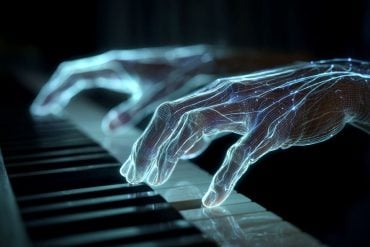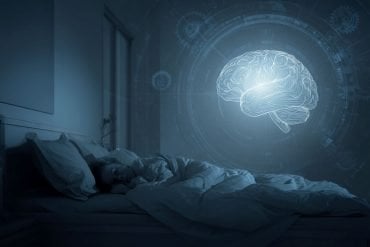Summary: A groundbreaking European trial has shown that a new electronic eye implant, paired with augmented-reality glasses, can restore reading vision to patients blinded by geographic atrophy from dry age-related macular degeneration (AMD). The device, called the PRIMA System, enabled 84% of participants to read letters, numbers, and words through previously sightless eyes.
The ultra-thin wireless microchip, acting like a miniature solar panel, transmits visual signals directly to the brain using near-infrared light. This breakthrough marks a new era in artificial vision, offering renewed independence and hope to millions living with untreatable blindness.
Key Facts:
- Restored Reading Vision: 84% of blind participants regained the ability to read after receiving the implant.
- Innovative Design: The PRIMA System uses a 2mm microchip paired with AR glasses to convert visual scenes into brain-interpretable electrical signals.
- Quality-of-Life Impact: Patients reported being able to read, do puzzles, and recognize text again—restoring confidence and independence.
Source: UCL
After being treated with an electronic eye implant paired with augmented-reality glasses, people with sight loss have recovered reading vision, reports a trial involving a UCL (University College London) and Moorfields Eye Hospital clinical researcher.
The results of the European clinical trial, published in The New England Journal of Medicine, showed 84% of participants were able to read letters, numbers and words using prosthetic vision through an eye that had previously lost its sight due to the untreatable progressive eye condition, geographic atrophy with dry age-related macular degeneration (AMD).

Those treated with the device could also read, on average, five lines of a vision chart; some participants could not even see the chart before their surgery.
The trial, with 38 patients in 17 hospital sites across five countries, was testing a pioneering device called PRIMA, with Moorfields Eye Hospital being the sole UK site. All patients had lost complete sight in their eye before receiving the implant.
Dry AMD is a slow deterioration of the cells of the macula over many years, as the light-sensitive retinal cells die off. For most people with dry AMD, they can experience a slight loss of central vision. Through a process known as geographic atrophy (GA), it can progress to full sight loss in the eye, as the cells die and the central macula melts away.
There is currently no treatment for GA, which affects 5 million people globally. All participants in this trial had lost the central sight of the eye being tested, leaving only limited peripheral vision.
This revolutionary new implant is the first ever device to enable people to read letters, numbers and words through an eye that had lost its sight.
Mr Mahi Muqit, associate professor in the UCL Institute of Ophthalmology and senior vitreoretinal consultant at Moorfields Eye Hospital, who led the UK arm of the trial, said: “In the history of artificial vision, this represents a new era. Blind patients are actually able to have meaningful central vision restoration, which has never been done before.
“Getting back the ability to read is a major improvement in their quality of life, lifts their mood and helps to restore their confidence and independence. The PRIMA chip operation can safely be performed by any trained vitreoretinal surgeon in under two hours – that is key for allowing all blind patients to have access to this new medical therapy for GA in dry AMD.”
The procedure involves a vitrectomy, where the eye’s vitreous jelly is removed from between the lens and the retina, and the surgeon inserts the ultra-thin microchip, which is shaped like a SIM card and just 2mm x 2mm. This is inserted under the centre of a patient’s retina, by creating a trapdoor into which the chip is posted.
The patient uses augmented-reality glasses, containing a video camera that is connected to a small computer, with a zoom feature, attached to their waistband.
Around a month or so after the operation, once the eye has settled, the new chip is activated. The video camera in the glasses projects the visual scene as an infra-red beam directly across the chip to activate the device.
Artificial intelligence (AI) algorithms through the pocket computer process this information, which is then converted into an electrical signal. This signal passes through the retinal and optical nerve cells into the brain, where it is interpreted as vision.
The patient uses their glasses to focus and scan across the main object in the projected image from the video camera, using the zoom feature to enlarge the text. Each patient goes through an intensive rehabilitation programme over several months to learn to interpret these signals and start reading again.
No significant decline in existing peripheral vison was observed in trial participants.
These findings pave the way for seeking approval to market this new device.
Sheila Irvine, one of Moorfields’ patients on the trial who was diagnosed with age-related macular degeneration, said: “I wanted to take part in research to help future generations, and my optician suggested I get in touch with Moorfields. Before receiving the implant, it was like having two black discs in my eyes, with the outside distorted.
“I was an avid bookworm, and I wanted that back. I was nervous, excited, all those things. There was no pain during the operation, but you’re still aware of what’s happening. It’s a new way of looking through your eyes, and it was dead exciting when I began seeing a letter. It’s not simple, learning to read again, but the more hours I put in, the more I pick up.
“The team at Moorfields has given me challenges, like ‘Look at your prescription’, which is always tiny. I like stretching myself, trying to look at the little writing on tins, doing crosswords.
“It’s made a big difference. Reading takes you into another world, I’m definitely more optimistic now.”
The global trial was led by Dr Frank Holz of the University of Bonn, with participants from the UK, France, Italy and the Netherlands.
The PRIMA System device used in this operation is being developed by Science Corporation (science.xyz), which develops brain-computer interfaces and neural engineering.
More about the device:
The device is a novel wireless subretinal photovoltaic implant paired with specialised glasses that project near-infrared light to the implant, which acts like a miniature solar panel.
It is 30 micrometres/microns (0.03mm) thick, about half the thickness of a human hair.
A zoom feature gives patients the ability to magnify letters. It is implanted in the subretinal layer, under the retinal cells that have died. Until the glasses and waistband computer are turned on, the implant has no visual stimulus or signal to pass through to the brain.
In addition to practicing their reading and attending regular training, patients on the trial were encouraged to explore ways of using the device. Sheila chose to learn to do puzzles and crosswords while one of the French patients used them to help navigate the Paris Metro – both tasks being more complex than reading alone.
Further quotes from Mr Mahi Muqit, UCL and Moorfields clinical researcher:
“My feeling is that the door is open for medical devices in this area, because there is no treatment currently licenced for dry AMD – it doesn’t exist.
“I think it’s something that, in future, could be used to treat multiple eye conditions.
“The rehabilitation process is key to these devices. It’s not like you’re popping a chip in the eye and then you can see again. You need to learn to use this type of vision.
“These are elderly patients who were no longer able to read, write or recognise faces due to lost vision. They couldn’t even see the vision chart before. They’ve gone from being in darkness to being able to start using their vision again, and studies have shown that reading is one of the things patients with progressive vision loss miss most.”
Key Questions Answered:
A: The PRIMA is a subretinal photovoltaic implant that converts light signals from AR glasses into electrical impulses that the brain interprets as vision.
A: The implant is designed for patients with dry AMD and geographic atrophy who have lost central vision but retain peripheral sight.
A: Participants who were completely blind in one eye were able to read up to five lines on a vision chart post-surgery—an unprecedented achievement in prosthetic vision.
About this visual neuroscience and neurotech research news
Author: Chris Lane
Source: UCL
Contact: Chris Lane – UCL
Image: The image is credited to Neuroscience News
Original Research: Closed access.
“Vision Restoration with a Neurostimulation System in Geographic Atrophy Due to AMD” by Mahi Muqit et al. NEJM
Abstract
Vision Restoration with a Neurostimulation System in Geographic Atrophy Due to AMD
Background
Geographic atrophy due to age-related macular degeneration (AMD) is the leading cause of irreversible blindness and affects more than 5 million persons worldwide. No therapies to restore vision in such persons currently exist.
The photovoltaic retina implant microarray (PRIMA) system combines a subretinal photovoltaic implant and glasses that project near-infrared light to the implant in order to restore sight to areas of central retinal atrophy.
Methods
We conducted an open-label, multicenter, prospective, single-group, baseline-controlled clinical study in which the vision of participants with geographic atrophy and a visual acuity of at least 1.2 logMAR (logarithm of the minimum angle of resolution) was assessed with PRIMA glasses and without PRIMA glasses at 6 and 12 months.
The primary end points were a clinically meaningful improvement in visual acuity (defined as ≥0.2 logMAR) from baseline to month 12 after implantation and the number and severity of serious adverse events related to the procedure or device through month 12.
Results
A total of 38 participants received a PRIMA implant, of whom 32 were assessed at 12 months. Of the 6 participants who were not assessed, 3 had died, 1 had withdrawn, and 2 were unavailable for testing. Among the 32 participants who completed 12 months of follow-up, the PRIMA system led to a clinically meaningful improvement in visual acuity from baseline in 26 (81%; 95% confidence interval, 64 to 93; P<0.001).
Using multiple imputation to account for the 6 participants with missing data, we estimated that 80% (95% CI, 66 to 94; P<0.001) of all participants would have had a clinically meaningful improvement at 12 months.
A total of 26 serious adverse events occurred in 19 participants. Twenty-one of these events (81%) occurred within 2 months after surgery, of which 20 (95%) resolved within 2 months after onset. The mean natural peripheral visual acuity after implantation was equivalent to that at baseline.
Conclusions
In this study involving 38 participants with geographic atrophy due to AMD, the PRIMA system restored central vision and led to a significant improvement in visual acuity from baseline to month 12. (Funded by Science Corporation and the Moorfields National Institute for Health and Care Research Biomedical Research Centre; PRIMAvera ClinicalTrials.gov number, NCT04676854.)






